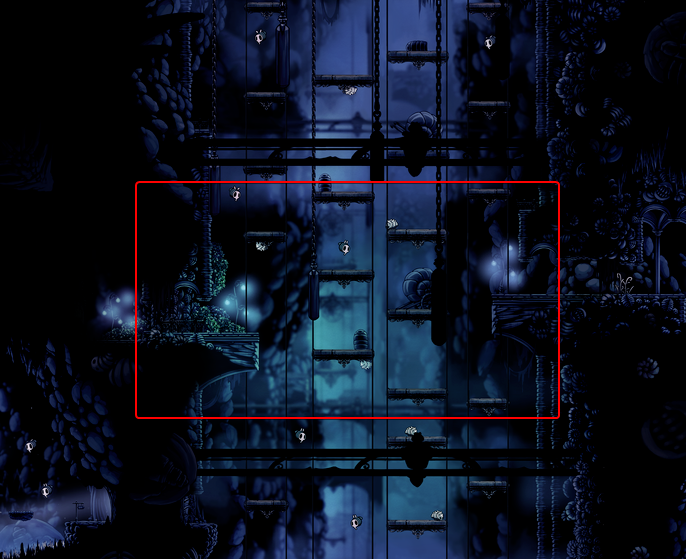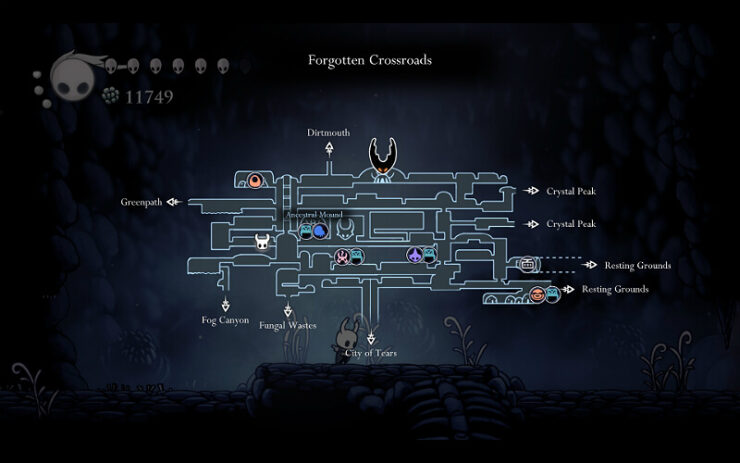

And I think Ari was keen to having a spidery area as well, which makes sense.


And we had a lantern item we talked about, so we wanted to have a dark area.
GREENPATH HOLLOW KNIGHT MAP FULL
It was a dangerous area full of predators, tight areas with stuff getting you. But we needed to have another area that connected to Bone Forest, and we had an area idea that we talked about, that was a combination of ideas. So basically, the next step was, we tore out Bone Forest from the right of the world and put it underneath, here. You can see how it kind of hooks into everything. Double jump is here, and it's in a whole new area in the final game. Bone Forest was pretty far along, and you can kinda see the full-on structure of it. Pellen: These areas that we've talked about, Greenpath, Fog Canyon, you can see how they've really taken shape. Gibson: Eventually, the bone forest didn't end up being a component of the game. The massive Bone Forest has moved to the bottom of the map. Eventually the bone forest, I remember Ari saying that he didn't like the lava land wasn't at the bottom of the world. So we started with this, and it got played around with a fair bit. Fungus 3 became Fog Canyon and the Queen's Gardens. Fungus 2 became the actual Fungal Wastes. It was Crystal Mines originally.Īri started thinking how he could differentiate these areas. C2 was, 'oh, it would be kind of interesting if you come back and revisit the initial crossroads area, right?' But how could we make it thematically slightly different? What if it kind of looks like it was the mines of the area? And that just ended up being broken off into a whole new area called Crystal Peak. We plotted a basic path through those areas, so you'd come from town, into the crossroads, into the fungus, get a powerup, go into the city, get a powerup, go into the bone forest, get a powerup, then come back and visit city 2, and then come back and revisit fungus, and by then you've done the game, come in and fight the last boss.Ī lot of these areas broke off into their own areas. You could actually run through it in black block mode… We actually had this whole world tiled out. Before we moved to Unity, the first five or six months of the game were in a program called Stencyl, a much smaller Game Maker type of thing. Pellen: This was the structure of the game for awhile. Team Cherry eventually softened that critical path. The numbers here outline a planned linear-ish progression through each area. When we think of the strength of Hollow Knight now, one of the things we really put effort into is the way map locations and things within the world kind of make sense. It wasn't fun from a storytelling perspective, and wasn't fun from a technical or design perspective. Each one of those could be taken up by a grub, or nothing, or a chest. Originally these sections, see how there's white lines along the black outline? Those were the potential exits and stuff, that we had to account for, so things could slot together in different ways. Pellen: the idea was, and obviously we abandoned this, we'd make all these prefab rooms and they'd be rearranged, so the interiors weren't going to be that randomized, but it would be like a tiny Metroidvania that would take an hour or two, but it would kinda rejig itself when you play, and you might get powerups in a different order or something. You can kinda see how that structure is pretty much the structure of the game, but really blown up, and the Dreamers are now all in different spots, but you still go out and fight those Dreamers, come back to the start, and fight the final boss.Īn early concept for Hollow Knight would use random generation to link rooms together. Once you defeated one in each land, you'd come back to the start and fight the final boss. Their masks still look similar, but now their bodies look different. Gibson: Which is the three Dreamers you kill. And the idea at the start was, you'd go down to the crossroads, and then each of these three areas would have one of the bosses, and it was just going to be the same boss, kind of slightly reskinned. And you can kinda see that shape, vaguely, still in the game. Then you had fungus area to the left, desert land on the right, and then underneath was the City of Tears. Pellen: One of the early ideas was town at the top area in the middle-the reason it's called Forgotten Crossroads is because it's in the middle, it's the crossroads to the world. Most of the enemies and rooms that ended up in Hollow Knight started life on paper.


 0 kommentar(er)
0 kommentar(er)
